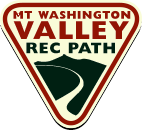- The recreation path will be built according to AASHTO (American Association of State Highway and Transportation Officials) standards and/or consideration of ADA accessibility.
- Wherever possible, the path would be constructed within a 12 foot wide corridor with a ten foot wide travel way. This standard width provides for 2-way bicycle/pedestrian/stroller/wheelchair traffic to pass unrestricted.
- The surface would be asphalt pavement, hard pack (stone dust) or crushed gravel with characteristics for appropriate drainage, durability, and comfortable use.
- A maximum grade of 5% is preferred, although short grades of 8% or less meet ADA standards. It is expected that a maximum of 5% grade should be achievable for the proposed route due to the relatively flat rail corridor and river valley terrain.
The following features will be incorporated into the design of the path:
- Occasional “bump outs” with benches
- Interpretive signage
- Bike racks near businesses and rest stops
- Sufficient trailhead parking and loading areas to support anticipated public use
- Amenities for seniors/elders as well as children
- Side trails to provide neighborhood access and scenic viewpoints
- Ramped curb cuts at road crossings
- Road signage for caution/yield at crossings
Based on generic cost estimates, a recreation path project can cost in the range of $450,000 per mile. This includes the costs of conceptual drawings, design & engineering, construction, and administration.
Based on this estimate, a 20-mile project would cost nearly $10 million, allowing for some additional spurs and connectors. Sections of the project could be built over time in short sections, spanning many years as feasibility and funding become available.

